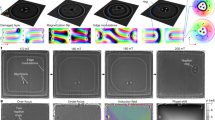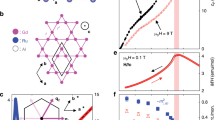Abstract
The concept of topology has dramatically expanded the research landscape of magnetism, leading to the discovery of numerous magnetic textures with intriguing topological properties. A magnetic skyrmion is an emergent topological magnetic texture with a string-like structure in three dimensions and a disk-like structure in one and two dimensions. Skyrmions in zero dimensions have remained elusive due to challenges from many competing orders. Here, by combining electron holography and micromagnetic simulations, we uncover the real-space magnetic configurations of a skyrmionic vortex structure confined in a B20-type FeGe tetrahedral nanoparticle. An isolated skyrmionic vortex forms at the ground state and this texture shows excellent robustness against temperature without applying a magnetic field. Our findings shed light on zero-dimensional geometrical confinement as a route to engineer and manipulate individual skyrmionic metastructures.
This is a preview of subscription content, access via your institution
Access options
Access Nature and 54 other Nature Portfolio journals
Get Nature+, our best-value online-access subscription
$29.99 / 30 days
cancel any time
Subscribe to this journal
Receive 12 print issues and online access
$259.00 per year
only $21.58 per issue
Buy this article
- Purchase on Springer Link
- Instant access to full article PDF
Prices may be subject to local taxes which are calculated during checkout





Similar content being viewed by others
Data availability
The data that support the findings of this study are available within the article and its Supplementary Information. Any other relevant data are also available upon reasonable request from the corresponding authors.
References
Allwood, D. A. et al. Magnetic domain-wall logic. Science 309, 1688–1692 (2005).
Parkin, S. S., Hayashi, M. & Thomas, L. Magnetic domain-wall racetrack memory. Science 320, 190–194 (2008).
Wolf, D., Lubk, A., Röder, F. & Lichte, H. Electron holographic tomography. Curr. Opin. Solid State Mater. Sci. 17, 126–134 (2013).
Wolf, D. et al. 3D magnetic induction maps of nanoscale materials revealed by electron holographic tomography. Chem. Mater. 27, 6771–6778 (2015).
Wolf, D. et al. Holographic vector field electron tomography of three-dimensional nanomagnets. Commun. Phys. 2, 87 (2019).
Hilger, A. et al. Tensorial neutron tomography of three-dimensional magnetic vector fields in bulk materials. Nat. Commun. 9, 4023 (2018).
Donnelly, C. et al. Three-dimensional magnetization structures revealed with X-ray vector nanotomography. Nature 547, 328–331 (2017).
Donnelly, C. et al. Tomographic reconstruction of a three-dimensional magnetization vector field. New J. Phys. 20, 083009 (2018).
Phatak, C., Petford-Long, A. K. & De Graef, M. Three-dimensional study of the vector potential of magnetic structures. Phys. Rev. Lett. 104, 253901 (2010).
Tanigaki, T. et al. Three-dimensional observation of magnetic vortex cores in stacked ferromagnetic discs. Nano Lett. 15, 1309–1314 (2015).
Streubel, R. et al. Retrieving spin textures on curved magnetic thin films with full-field soft X-ray microscopies. Nat. Commun. 6, 7612 (2015).
Lai, G. et al. Three-dimensional reconstruction of magnetic vector fields using electron-holographic interferometry. J. Appl. Phys. 75, 4593–4598 (1994).
Gubin, S. P. Magnetic Nanoparticles (Wiley-VCH, 2009).
Mühlbauer, S. et al. Magnetic small-angle neutron scattering. Rev. Mod. Phys. 91, 015004 (2019).
Skyrme, T. H. R. A unified field theory of mesons and baryons. Nucl. Phys. 31, 556–569 (1962).
Mühlbauer, S. et al. Skyrmion lattice in a chiral magnet. Science 323, 915–919 (2009).
Yu, X. Z. et al. Real-space observation of a two-dimensional skyrmion crystal. Nature 465, 901–904 (2010).
Jonietz, F. et al. Spin transfer torques in MnSi at ultralow current densities. Science 330, 1648–1651 (2010).
Nagaosa, N. & Tokura, Y. Topological properties and dynamics of magnetic skyrmions. Nat. Nanotechnol. 8, 899–911 (2013).
Fert, A., Cros, V. & Sampaio, J. Skyrmions on the track. Nat. Nanotechnol. 8, 152–156 (2013).
Parkin, S. & Yang, S. H. Memory on the racetrack. Nat. Nanotechnol. 10, 195–198 (2015).
Liang, D., DeGrave, J. P., Stolt, M. J., Tokura, Y. & Jin, S. Current-driven dynamics of skyrmions stabilized in MnSi nanowires revealed by topological Hall effect. Nat. Commun. 6, 8217 (2015).
Fert, A., Reyren, N. & Cros, V. Magnetic skyrmions: advances in physics and potential applications. Nat. Rev. Mater. 2, 17031 (2017).
Sampaio, J., Cros, V., Rohart, S., Thiaville, A. & Fert, A. Nucleation, stability and current-induced motion of isolated magnetic skyrmions in nanostructures. Nat. Nanotechnol. 8, 839–844 (2013).
Jiang, W. et al. Magnetism. Blowing magnetic skyrmion bubbles. Science 349, 283–286 (2015).
Du, H. et al. Edge-mediated skyrmion chain and its collective dynamics in a confined geometry. Nat. Commun. 6, 8504 (2015).
Jin, C. et al. Control of morphology and formation of highly geometrically confined magnetic skyrmions. Nat. Commun. 8, 15569 (2017).
Iwasaki, J., Mochizuki, M. & Nagaosa, N. Current-induced skyrmion dynamics in constricted geometries. Nat. Nanotechnol. 8, 742–747 (2013).
Mathur, N., Stolt, M. J. & Jin, S. Magnetic skyrmions in nanostructures of non-centrosymmetric materials. APL Mater. 7, 120703 (2019).
Yu, X. Z. et al. Near room-temperature formation of a skyrmion crystal in thin-films of the helimagnet FeGe. Nat. Mater. 10, 106–109 (2011).
Zhao, X. et al. Direct imaging of magnetic field-driven transitions of skyrmion cluster states in FeGe nanodisks. Proc. Natl Acad. Sci. USA 113, 4918–4923 (2016).
Matsumoto, T., So, Y. G., Kohno, Y., Ikuhara, Y. & Shibata, N. Stable magnetic skyrmion states at room temperature confined to corrals of artificial surface pits fabricated by a focused electron beam. Nano Lett. 18, 754–762 (2018).
Rohart, S. & Thiaville, A. Skyrmion confinement in ultrathin film nanostructures in the presence of Dzyaloshinskii–Moriya interaction. Phys. Rev. B 88, 184422 (2013).
Beg, M. et al. Ground state search, hysteretic behaviour, and reversal mechanism of skyrmionic textures in confined helimagnetic nanostructures. Sci. Rep. 5, 17137 (2015).
Zheng, F. et al. Direct imaging of a zero-field target skyrmion and its polarity switch in a chiral magnetic nanodisk. Phys. Rev. Lett. 119, 197205 (2017).
Stolt, M. J. et al. Selective chemical vapor deposition growth of cubic FeGe nanowires that support stabilized magnetic skyrmions. Nano Lett. 17, 508–514 (2017).
Hou, Z. et al. Creation of single chain of nanoscale skyrmion bubbles with record-high temperature stability in a geometrically confined nanostripe. Nano Lett. 18, 1274–1279 (2018).
Moon, K. et al. Spontaneous interlayer coherence in double-layer quantum Hall systems: charged vortices and Kosterlitz–Thouless phase transitions. Phys. Rev. B 51, 5138–5170 (1995).
Rybakov, F., Borisov, A. & Bogdanov, A. Three-dimensional skyrmion states in thin films of cubic helimagnets. Phys. Rev. B 87, 094424 (2013).
Tchernyshyov, O. & Chern, G. W. Fractional vortices and composite domain walls in flat nanomagnets. Phys. Rev. Lett. 95, 197204 (2005).
Almeida, T. P. et al. Direct visualization of the thermomagnetic behavior of pseudo-single-domain magnetite particles. Sci. Adv. 2, e1501801 (2016).
Bogdanov, A. N. & Rössler, U. K. Chiral symmetry breaking in magnetic thin films and multilayers. Phys. Rev. Lett. 87, 037203 (2001).
Cubukcu, M. et al. Dzyaloshinskii–Moriya anisotropy in nanomagnets with in-plane magnetization. Phys. Rev. B 93, 020401 (2016).
Volkov, M. O. et al. Mesoscale Dzyaloshinskii–Moriya interaction: geometrical tailoring of the magnetochirality. Sci. Rep. 8, 866 (2018).
Harada, K., Tonomura, A., Togawa, Y., Akashi, T. & Matsuda, T. Double-biprism electron interferometry. Appl. Phys. Lett. 84, 3229–3231 (2004).
Shindo, D. & Murakami, Y. Electron holography of magnetic materials. J. Phys. D 41, 183002 (2008).
Vansteenkiste, A. et al. The design and verification of MuMax3. AIP Adv. 4, 107133 (2014).
Dyadkin, V. A. et al. Control of chirality of transition-metal monosilicides by the Czochralski method. Phys. Rev. B 84, 014435 (2011).
Morikawa, D. et al. Determination of crystallographic chirality of MnSi thin film grown on Si(111) substrate. Phys. Rev. Mater. 4, 014407 (2020).
Acknowledgements
K.N. was supported by a Grant-in-Aid for Scientific Research (B) (number 19H02418) and for Challenging Research (Exploratory) (number 19K22052) from the JSPS. X.Y. was supported by a Grant-in-Aid for Scientific Research (A) (number 19H00660) from the JSPS and JST CREST (grant number JPMJCR20T1). N.N. was supported by JST CREST (grant number JPMJCR1874). A.C.B. and J.Z. acknowledge support from the US Department of Energy (DOE), Office of Science, Basic Energy Sciences (BES) under award number DE-SC0020221. Y.L. was supported by the Special Postdoctoral Researcher programme of RIKEN. N.M., M.J.S. and S.J. were supported by US NSF grant ECCS-1609585. M.J.S. also acknowledges support from the NSF Graduate Research Fellowship Program.
Author information
Authors and Affiliations
Contributions
S.J. and Y.T. conceived the project. N.M., M.J.S. and S.J. synthesized the FeGe particles. Y.L., A.C.B. and J.Z. performed the micromagnetic simulations. K.N. performed the EH observations and model-based simulations. K.N., Y.L. and J.Z. wrote the manuscript. All authors discussed the data and revised the manuscript.
Corresponding authors
Ethics declarations
Competing interests
The authors declare no competing interests.
Peer review
Peer review information
Nature Materials thanks Shawn D. Pollard and the other, anonymous, reviewer(s) for their contribution to the peer review of this work.
Additional information
Publisher’s note Springer Nature remains neutral with regard to jurisdictional claims in published maps and institutional affiliations.
Supplementary information
Supplementary Information
Supplementary notes 1–5, references 1–7, Figs. 1–22 and captions of Movies 1–4.
Supplementary Video 1
Simulated 3D view of the skyrmionic vortex in a 145 nm tetrahedron (in-plane (xy plane) magnetic component).
Supplementary Video 2
Simulated 3D view of the skyrmionic vortex in a 145 nm tetrahedron (out-of-plane (z axis) magnetic component).
Supplementary Video 3
Sliced vector plots of the skyrmionic vortex in a 145 nm tetrahedron.
Supplementary Video 4
Sliced vector plots of the skyrmionic vortex in a 185 nm tetrahedron.
Rights and permissions
About this article
Cite this article
Niitsu, K., Liu, Y., Booth, A.C. et al. Geometrically stabilized skyrmionic vortex in FeGe tetrahedral nanoparticles. Nat. Mater. 21, 305–310 (2022). https://doi.org/10.1038/s41563-021-01186-x
Received:
Accepted:
Published:
Issue Date:
DOI: https://doi.org/10.1038/s41563-021-01186-x
This article is cited by
-
Building skyrmions through frustration
Nature Materials (2022)



